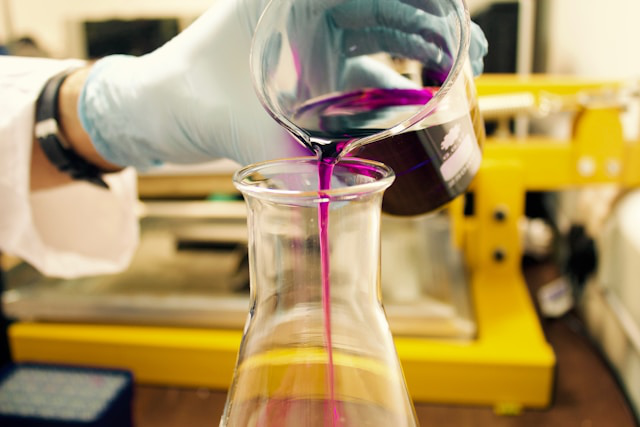Have you ever wondered how chemists know exactly how much of each substance to use in a reaction? The answer lies in a fundamental concept called stoichiometry. This crucial aspect of chemistry helps scientists and students alike understand the quantitative relationships in chemical reactions, ensuring that no atom is wasted. In this post, we’ll delve into what stoichiometry is, explore some engaging stoichiometry examples, and provide you with practical stoichiometry practice problems. Whether you’re just getting started or looking to sharpen your skills, this guide will equip you with the knowledge and tools to tackle stoichiometry problems with confidence.
What We Review
What is Stoichiometry?
Stoichiometry is like the recipe for a cake, but instead of baking, we’re dealing with chemical reactions. At its core, stoichiometry is the study of the quantitative relationships between the reactants and products in chemical reactions. When chemists conduct experiments, they need to know how much of each reactant to use and what amount of product to expect. Stoichiometry provides these answers, ensuring that chemical reactions are efficient and effective.
Understanding the Basics
To grasp stoichiometry, you first need to be familiar with a few key concepts:
- Moles: Just like a dozen represents 12 items, a mole is a specific number of molecules (approximately 6.022\times10^{23} molecules, known as Avogadro’s number).
- Molar Mass: This is the weight of one mole of a substance, typically expressed in grams per mole (g/mol). It tells you how much one mole of a substance weighs.
- Mole Ratios: These ratios come from the coefficients of a balanced chemical equation. They tell you the proportion of reactants and products in a reaction.
Real-World Applications

Stoichiometry isn’t just a topic in your chemistry textbook; it has real-world applications. Pharmacists use stoichiometry to mix medications, environmental scientists use it to track pollutant levels, and engineers apply it to design reactors. Understanding stoichiometry means you’re learning a skill that scientists and professionals use daily to make the world work.
Stoichiometry Examples
Understanding stoichiometry becomes clearer with practical examples. Let’s explore a couple of scenarios to illustrate how stoichiometry helps us solve chemical equations.
Example 1: Water Formation
Consider the chemical reaction where hydrogen and oxygen combine to form water:
2H_2 + O_2 \rightarrow 2H_2O
If we start with 36.0 grams of H_2 and have an excess of O_2, how many grams of H_2O can we produce? The molar mass of H_2 is 2.02 g/mol, and for H_2O, it’s 18.02 g/mol.
First, convert the mass of H_2 to moles:
\frac{36.0 \text{ g } H_2}{2.02 \text{ g/mol}} = 17.82 \text{ moles } H_2
Applying the mole ratio from the balanced equation, calculate the moles of H_2O produced:
17.82 \text{ moles } H_2 \times \frac{2 \text{ moles } H_2O}{2 \text{ moles } H_2} = 17.82 \text{ moles } H_2O
Then, convert moles of H_2O to grams:
17.82 \text{ moles } H_2O \times 18.02 \text{ g/mol} = 321.15 \text{ g } H_2O
Thus, 36.0 grams of H_2 can produce 321.15 grams of H_2O.
Example 2: Ammonia Synthesis
Now, let’s examine another one of our stoichiometry examples. This problem examines the synthesis of ammonia (NH_3) from nitrogen (N_2) and hydrogen (H_2) in a reaction conducted at STP (standard temperature and pressure):
N_2 + 3H_2 \rightarrow 2NH_3
If we begin with 22.4 liters of N_2 (1 mole at STP) and have an excess of H_2, how many grams of NH_3 can be produced? The molar mass of NH_3 is 17.03 g/mol.
Using the mole ratio from the chemical equation:
1.0 \text{ mole } N_2 \times \frac{2 \text{ moles } NH_3}{1 \text{ mole } N_2} = 2.0 \text{ moles } NH_3
Then, convert moles of NH_3 to grams:
2.0 \text{ moles } NH_3 \times 17.03 \text{ g/mol} = 34.06 \text{ g } NH_3
This result shows that 22.4 liters of N_2 at STP can produce 34.06 grams of NH_3.
Guided Stoichiometry Practice
To master stoichiometry, practice is key. In this section, we’ll explore strategies to approach stoichiometry problems and provide some guided practice examples. These strategies will help you develop a systematic approach to solving stoichiometry questions, enhancing your problem-solving skills.
Understanding the Approach
Identify What’s Given and What’s Unknown: Start by determining what information is provided in the problem and what you need to find. This could be the amount of reactants, products, or even the coefficients in a balanced chemical equation.
Write the Balanced Chemical Equation: Ensure you have the correct balanced chemical equation for the reaction you’re analyzing. This step is crucial as it sets the foundation for the stoichiometric calculations.
Use Mole Ratios: Utilize the coefficients from the balanced equation to establish mole ratios. These ratios are the heart of stoichiometry, allowing you to convert between amounts of reactants and products.
Perform the Calculations: With the mole ratios, you can perform calculations to find the unknown quantities. Remember to keep track of your units, ensuring they are consistent throughout the calculation.
Guided Example
Let’s practice with a guided example. Consider the combustion of propane (C_3H_8) in oxygen to produce carbon dioxide and water:
C_3H_8 + 5O_2 \rightarrow 3CO_2 + 4H_2O
Suppose you start with 44.1 grams of propane (C_3H_8) and have an excess of oxygen (O_2). How many grams of carbon dioxide (CO_2) are produced?
Given: 44.1 grams of C_3H_8
The molar mass of C_3H_8 is 44.1 g/mol, and for CO_2, it’s 44.0 g/mol.
Unknown: Grams of CO_2 produced
First, convert the mass of C_3H_8 to moles:
\frac{44.1 \text{ g } C_3H_8}{44.1 \text{ g/mol}} = 1.00 \text{ mole } C_3H_8
Mole Ratio: From the balanced equation, the mole ratio of C_3H_8 to CO_2 is 1:3.
Calculation:
1.00 \text{ mole of } C_3H_8 \times \frac{3 \text{ moles of } CO_2}{1 \text{ mole of } C_3H_8} = 3.00 \text{ moles of } CO_2
Now, convert the moles of CO_2 to grams:
3.00 \text{ moles of } CO_2 \times 44.0 \text{ g/mol} = 132.0 \text{ g } CO_2
So, 44.1 grams of C_3H_8 produces 132.0 grams of CO_2.
Stoichiometry Practice Problems
Now that you’ve seen stoichiometry in action through examples, it’s time to test your knowledge with some practice problems. Try to solve these problems on your own before checking the solutions provided. This will help you understand stoichiometry better and prepare you for similar problems in the future.
Problem 1:
When magnesium burns in the air, it reacts with oxygen to form magnesium oxide. The balanced chemical equation for this reaction is:
2Mg + O_2 \rightarrow 2MgO
If you start with 24.0 grams of magnesium (Mg) and have an excess of oxygen (O_2), how many grams of magnesium oxide (MgO) will be produced? The molar mass of Mg is 24.3 g/mol, and MgO is 40.3 g/mol.
Problem 2:
Hydrochloric acid reacts with sodium hydroxide to produce sodium chloride and water in the following reaction:
HCl + NaOH \rightarrow NaCl + H_2O
If 36.5 grams of hydrochloric acid (HCl) react with sufficient sodium hydroxide (NaOH), how many grams of sodium chloride (NaCl) are produced? Assume the molar mass of HCl is 36.5 g/mol and NaCl is 58.4 g/mol.
Problem 3:
Nitrogen gas can react with hydrogen gas to form ammonia through the following reaction:
N_2 + 3H_2 \rightarrow 2NH_3
Calculate the amount of ammonia (NH_3) produced (in grams) when 28.0 liters of nitrogen gas (N_2) react with an excess of hydrogen gas (H_2) at STP. The molar mass of NH_3 is [/latex]17.03[/latex] g/mol.
Stoichiometry Practice Problems Solutions
Here, we’ll go through the solutions to the stoichiometry practice problems we presented earlier. These solutions will help you understand the step-by-step process involved in solving stoichiometry problems.
Solution to Problem 1:
For the reaction 2Mg + O_2 \rightarrow 2MgO, we’re starting with 24.0 grams of Mg. First, convert the mass of Mg to moles:
\frac{24.0 \text{ g Mg}}{24.3 \text{ g/mol}} = 0.9877 \text{ moles Mg}
Using the stoichiometry of the reaction, convert moles of Mg to moles of MgO (the ratio is 1:1):
0.9877 \text{ moles Mg} \times \frac{2 \text{ moles MgO}}{2 \text{ moles Mg}} = 0.9877 \text{ moles MgO}
Now, convert moles of MgO to grams:
0.9877 \text{ moles MgO} \times 40.3 \text{ g/mol} = 39.81 \text{ g MgO}
So, 24.0 grams of Mg will produce 39.81 grams of MgO.
Solution to Problem 2:
For the reaction HCl + NaOH \rightarrow NaCl + H_2O, we start with 36.5 grams of HCl. Convert the mass of HCl to moles:
\frac{36.5 \text{ g HCl}}{36.5 \text{ g/mol}} = 1.00 \text{ mole HCl}
The mole ratio of HCl to NaCl is 1:1, so:
1.00 \text{ mole HCl} \times \frac{1 \text{ mole NaCl}}{1 \text{ mole HCl}} = 1.00 \text{ mole NaCl}
Now, convert moles of NaCl to grams:
1.00 \text{ mole NaCl} \times 58.44 \text{ g/mol} = 58.44 \text{ g NaCl}
Thus, 36.5 grams of HCl will produce 58.44 grams of NaCl.
Solution to Problem 3:
For the reaction N_2 + 3H_2 \rightarrow 2NH_3, starting with 28.0 liters of N_2 at STP (which corresponds to 1.00 mole of N_2):
28.0 \text{ L N}_2 \times \frac{1 \text{ mole N}_2}{22.4 \text{ L N}_2} = 1.25 \text{ moles N}_2
Using the stoichiometry of the reaction (1:2 ratio of N_2 to NH_3):
1.25 \text{ moles N}_2 \times \frac{2 \text{ moles NH}_3}{1 \text{ mole N}_2} = 2.50 \text{ moles NH}_3
Convert moles of NH_3 to grams:
2.50 \text{ moles NH}_3 \times 17.03 \text{ g/mol} = 42.575 \text{ g NH}_3
So, 28.0 liters of N_2 will produce 42.575 grams of NH_3.
Conclusion
Stoichiometry is a cornerstone concept in chemistry that enables us to predict and quantify the outcomes of chemical reactions. By understanding the relationships between reactants and products, chemists can conduct reactions efficiently and effectively. Throughout this post, we’ve explored what stoichiometry is, provided clear examples, and offered practice problems to help you build your skills.
Remember, the key to mastering stoichiometry lies in practice. The more you work through problems, the more intuitive these concepts will become. Whether you’re balancing equations, calculating molar masses, or determining the amounts of reactants and products, each step you take strengthens your understanding of chemistry.
We encourage you to revisit these examples and practice problems regularly, and don’t hesitate to explore more complex scenarios as you become more comfortable with the basics. Stoichiometry is not just a topic for the classroom; it’s a tool that scientists use to make real-world decisions in industries, research, and environmental science.
So, keep practicing, stay curious, and remember that every chemical equation tells a story of transformation and interaction. With stoichiometry, you’re equipped to understand and narrate these fascinating stories of science.








